Global Digital X-Ray Equipment Market By Product, By Portability, By Application, By End User, By Region & Segmental Insights Trends and Forecast, 2024 – 2034
- Industry: Healthcare
- Report ID: TNR-110-1191
- Number of Pages: 420
- Table/Charts : Yes
- June, 2024
- Base Year : 2024
- No. of Companies : 10+
- No. of Countries : 29
- Views : 10156
- Covid Impact Covered: Yes
- War Impact Covered: Yes
- Formats : PDF, Excel, PPT
Digital X-ray equipment utilizes advanced digital imaging technology to capture and display X-ray images, replacing traditional film-based systems. These systems convert X-ray photons into electronic signals, producing high-resolution images that can be viewed immediately on a computer screen. The benefits include faster image processing, enhanced image quality, reduced radiation exposure, and easier storage and sharing of images. The digital X-ray equipment market is experiencing robust growth, driven by technological advancements, the rising prevalence of chronic diseases, and an increasing focus on non-invasive diagnostic procedures.
A significant trend in the market is the integration of artificial intelligence (AI), which enhances diagnostic accuracy and efficiency through automated image analysis and advanced algorithms. Another notable trend is the growing adoption of portable digital X-ray systems, which offer mobility and convenience, particularly in emergency and remote settings.
Opportunities in the market are vast, with increasing investments in healthcare infrastructure and a growing emphasis on early disease detection and preventive care. The aging global population and the rising incidence of conditions like cancer and cardiovascular diseases further propel market growth. Government initiatives promoting digital healthcare transformation and the expansion of telemedicine also create favorable conditions for market expansion.
Growth drivers include the demand for quicker diagnostic results, the need for improved patient outcomes, and the continuous innovation in digital imaging technologies. As healthcare providers strive to enhance diagnostic capabilities and operational efficiency, the digital X-ray equipment market is poised for significant growth in the coming years.
In terms of revenue, the global digital x-ray equipment market was worth US$ 6.9 Bn in 2023, anticipated to witness a CAGR of 4.2% during 2024 – 2034.

Trends in the Global Digital X-Ray Equipment Market
- The integration of artificial intelligence (AI) in digital X-ray equipment is a significant trend reshaping the market. AI-powered systems enhance diagnostic accuracy by automating image analysis, detecting abnormalities with high precision, and reducing the risk of human error. This technology speeds up the diagnostic process, allowing for quicker decision-making and improved patient outcomes. AI algorithms can also assist in triaging cases, prioritizing urgent conditions for immediate attention. The ability to learn and adapt from vast amounts of imaging data makes AI a valuable tool for radiologists, enhancing their efficiency and productivity. As healthcare providers increasingly recognize the benefits of AI in radiology, investments in AI-integrated digital X-ray systems are expected to grow, driving innovation and transforming diagnostic practices.
- The increasing adoption of portable digital X-ray systems is a prominent trend in the market. Portable X-ray machines offer significant advantages, including enhanced mobility, convenience, and the ability to perform imaging at the patient’s location, whether in a hospital, clinic, or home care setting. This trend is particularly driven by the growing need for point-of-care diagnostics and the demand for efficient medical services in remote and underserved areas. Portable systems are also invaluable during emergencies, allowing for immediate imaging without the need to transport patients. Technological advancements have improved the image quality and functionality of these portable devices, making them as reliable as stationary systems. As healthcare continues to prioritize patient-centered care and operational efficiency, the popularity of portable digital X-ray systems is expected to rise.
Global Digital X-Ray Equipment Market Revenue & Forecast, (US$ Million), 2016 – 2034
Direct radiography by product have seen a surge in popularity recently, emerging as the fastest-growing segment in the global digital x-ray equipment market.
DR technology offers immediate image acquisition, eliminating the need for intermediate processing steps, which significantly enhances workflow efficiency in medical facilities. This technology provides high-quality images with reduced radiation exposure, contributing to improved patient safety. The rise in demand for quick and accurate diagnostic results, coupled with the increasing prevalence of chronic diseases, has fuelled the adoption of DR systems. Moreover, advancements in digital imaging technology and integration with artificial intelligence for automated image analysis have further propelled the growth of this segment. Healthcare providers are increasingly investing in DR equipment to improve diagnostic accuracy and patient care, making it a pivotal component in modern radiographic practices.
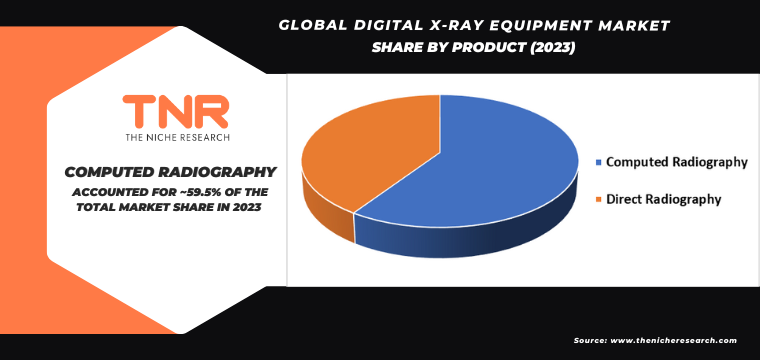
In 2023, portable systems led the global digital x-ray equipment market, commanding a significant revenue share of 60.2%.
The portability of these systems offers unparalleled convenience, enabling medical professionals to conduct diagnostic imaging at the patient’s bedside or in remote locations, thus enhancing accessibility and efficiency in healthcare delivery. The rise in demand for home healthcare services and the increasing need for on-the-spot diagnostics during emergencies have significantly contributed to the popularity of portable X-ray systems. Furthermore, technological advancements have improved the image quality and functionality of portable devices, making them comparable to traditional stationary systems. Their ease of use, combined with the ability to quickly and accurately diagnose conditions without requiring patients to be transported, has solidified their position as a crucial asset in modern medical practices.
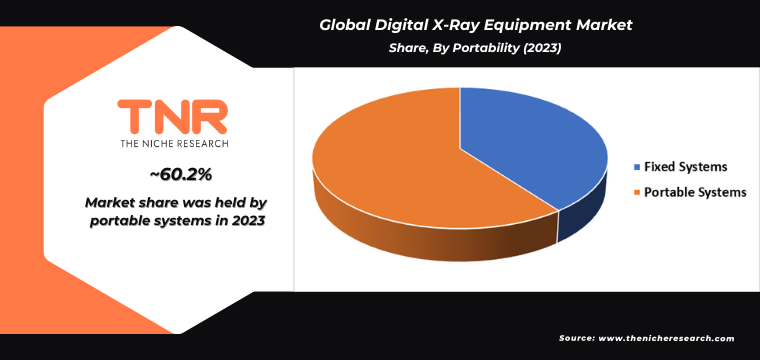
In 2023, orthopaedic segment emerged as the second largest segment in the global digital x-ray equipment market, capturing a notable revenue share of 23.7%.
This growth is driven by the increasing prevalence of musculoskeletal disorders and the rising number of sports-related injuries, which necessitate precise and reliable imaging for accurate diagnosis and treatment planning. Advanced digital X-ray technology offers superior image clarity and the ability to capture detailed images of bones and joints, enhancing the diagnostic capabilities of orthopaedic specialists. The integration of digital radiography with image analysis software further aids in detecting fractures, bone deformities, and other orthopaedic conditions. Additionally, the growing aging population, which is more susceptible to bone-related ailments, has further fueled the demand for advanced orthopaedic imaging solutions, solidifying its significant market presence.
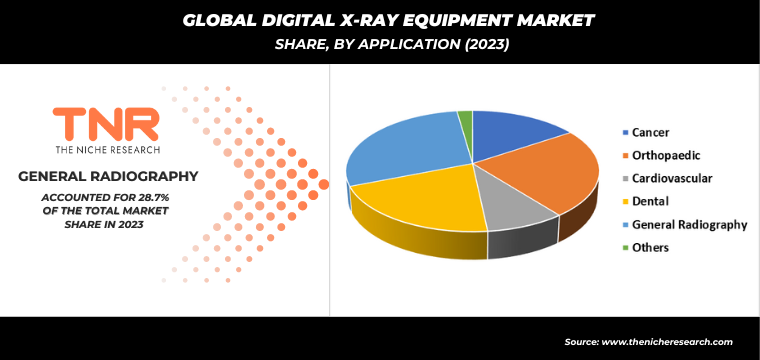
Hospitals and clinics segment by end user achieved the highest share in the global digital x-ray equipment market in 2023.
This segment achieved the highest share due to the extensive utilization of advanced imaging technologies in healthcare settings for accurate and efficient diagnostic services. Hospitals and clinics, equipped with substantial budgets and the need for comprehensive diagnostic capabilities, are continuously investing in state-of-the-art digital X-ray systems. These systems offer enhanced image quality, faster processing times, and reduced radiation exposure, making them indispensable tools for a wide range of medical applications. The increasing prevalence of chronic diseases and the rising demand for non-invasive diagnostic procedures have further driven the adoption of digital X-ray equipment in these facilities, underscoring their pivotal role in modern healthcare delivery.
Europe is anticipated as the fastest growing region during the forecast timeline. This growth is driven by several factors, including the region’s advanced healthcare infrastructure, increasing investments in medical technology, and supportive government initiatives promoting digital healthcare transformation. The rising prevalence of chronic diseases and an aging population necessitate advanced diagnostic tools, fueling the demand for digital X-ray equipment. European countries are also witnessing a surge in technological innovations and the integration of AI in radiology, enhancing diagnostic accuracy and efficiency. Furthermore, the presence of leading market players and their focus on expanding product portfolios and improving distribution networks in Europe contribute to the region’s robust growth outlook in the digital X-ray equipment market.
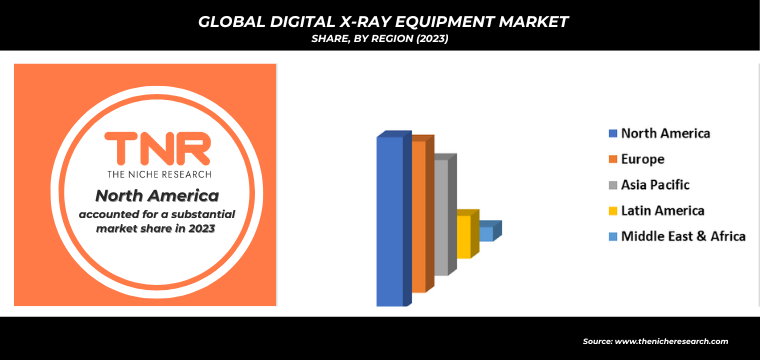
Competitive Landscape
The digital X-ray equipment market is highly competitive, driven by technological advancements and the demand for efficient diagnostic tools. Major players include Siemens Healthineers, GE Healthcare, and Philips Healthcare, focusing on innovation and integration of AI for enhanced imaging quality. Emerging companies are leveraging niche markets and cost-effective solutions. The competition is also intensified by the increasing adoption of digital radiography in healthcare facilities worldwide, aiming for better patient outcomes and operational efficiency.
Some of the players operating in the digital x-ray equipment market are
- Agfa-Gevaert N.V. Healthcare
- Allengers Medical Systems Limited
- Boston Imaging
- Canon USA Inc.
- GE Healthcare
- Philips Healthcare
- Samsung Medison
- Shimadzu Corporation
- Siemens AG
- Toshiba Corporation
- Trivitron Healthcare
- Varex Imaging Corporation
- Varian Medical Systems
- Other Industry Participants
Global Digital X-Ray Equipment Market Scope
| Report Specifications | Details |
| Market Revenue in 2023 | US$ 6.9 Bn |
| Market Size Forecast by 2034 | US$ 10.8 Bn |
| Growth Rate (CAGR) | 4.2% |
| Historic Data | 2016 – 2022 |
| Base Year for Estimation | 2023 |
| Forecast Period | 2024 – 2034 |
| Report Inclusions | Market Size & Estimates, Market Dynamics, Competitive Scenario, Trends, Growth Factors, Market Determinants, Key Investment Segmentation, Product/Service/Solutions Benchmarking |
| Segments Covered | By Product, By Portability, By Application, By End User, By Region |
| Regions Covered | North America, Europe, Asia Pacific, Middle East & Africa, Latin America |
| Countries Covered | U.S., Canada, Mexico, Rest of North America, France, The UK, Spain, Germany, Italy, Nordic Countries (Denmark, Finland, Iceland, Sweden, Norway), Benelux Union (Belgium, The Netherlands, Luxembourg), Rest of Europe, China, Japan, India, New Zealand, Australia, South Korea, Southeast Asia (Indonesia, Thailand, Malaysia, Singapore, Rest of Southeast Asia), Rest of Asia Pacific, Saudi Arabia, UAE, Egypt, Kuwait, South Africa, Rest of Middle East & Africa, Brazil, Argentina, Rest of Latin America |
| Key Players | Agfa-Gevaert N.V. Healthcare, Allengers Medical Systems Limited, Boston Imaging, Canon USA Inc., GE Healthcare, Philips Healthcare, Samsung Medison, Shimadzu Corporation, Siemens AG, Toshiba Corporation, Trivitron Healthcare, Varex Imaging Corporation, Varian Medical Systems |
| Customization Scope | Customization allows for the inclusion/modification of content pertaining to geographical regions, countries, and specific market segments. |
| Pricing & Procurement Options | Explore purchase options tailored to your specific research requirements |
| Contact Details | Consult With Our Expert
Japan (Toll-Free): +81 663-386-8111 South Korea (Toll-Free): +82-808- 703-126 Saudi Arabia (Toll-Free): +966 800-850-1643 United Kingdom: +44 753-710-5080 United States: +1 302-232-5106 E-mail: askanexpert@thenicheresearch.com
|
Global Digital X-Ray Equipment Market
By Product
- Computed Radiography
- Direct Radiography
By Portability
- Fixed Systems
- Portable Systems
By Application
- Cancer
- Orthopedic
- Cardiovascular
- Dental
- General Radiography
- Others
By End User
- Hospitals and Clinics
- Diagnostic Centers
- Research Institutes
- Others
By Region
- North America (U.S., Canada, Mexico, Rest of North America)
- Europe (France, The UK, Spain, Germany, Italy, Nordic Countries (Denmark, Finland, Iceland, Sweden, Norway), Benelux Union (Belgium, The Netherlands, Luxembourg), Rest of Europe)
- Asia Pacific (China, Japan, India, New Zealand, Australia, South Korea, Southeast Asia (Indonesia, Thailand, Malaysia, Singapore, Rest of Southeast Asia), Rest of Asia Pacific)
- Middle East & Africa (Saudi Arabia, UAE, Egypt, Kuwait, South Africa, Rest of Middle East & Africa)
- Latin America (Brazil, Argentina, Rest of Latin America)
Report Layout:
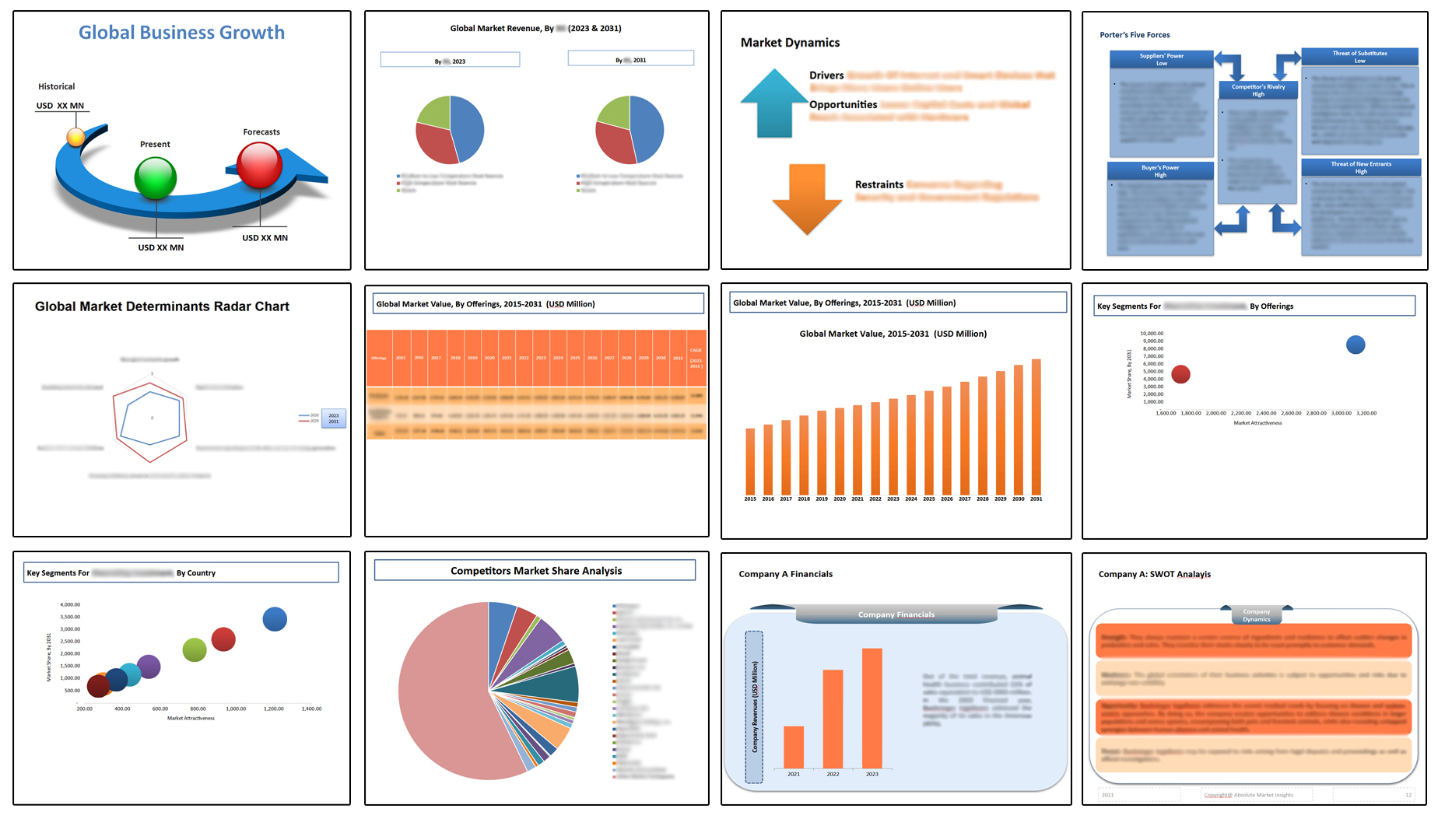
Table of Contents
Note: This ToC is tentative and can be changed according to the research study conducted during the course of report completion.
**Exclusive for Multi-User and Enterprise User.
Global Digital X-Ray Equipment Market
By Product
- Computed Radiography
- Direct Radiography
By Portability
- Fixed Systems
- Portable Systems
By Application
- Cancer
- Orthopedic
- Cardiovascular
- Dental
- General Radiography
- Others
By End User
- Hospitals and Clinics
- Diagnostic Centers
- Research Institutes
- Others
By Region
- North America (U.S., Canada, Mexico, Rest of North America)
- Europe (France, The UK, Spain, Germany, Italy, Nordic Countries (Denmark, Finland, Iceland, Sweden, Norway), Benelux Union (Belgium, The Netherlands, Luxembourg), Rest of Europe)
- Asia Pacific (China, Japan, India, New Zealand, Australia, South Korea, Southeast Asia (Indonesia, Thailand, Malaysia, Singapore, Rest of Southeast Asia), Rest of Asia Pacific)
- Middle East & Africa (Saudi Arabia, UAE, Egypt, Kuwait, South Africa, Rest of Middle East & Africa)
- Latin America (Brazil, Argentina, Rest of Latin America)
The Niche Research approach encompasses both primary and secondary research methods to provide comprehensive insights. While primary research is the cornerstone of our studies, we also incorporate secondary research sources such as company annual reports, premium industry databases, press releases, industry journals, and white papers.
Within our primary research, we actively engage with various industry stakeholders, conducting paid interviews and surveys. Our meticulous analysis extends to every market participant in major countries, allowing us to thoroughly examine their portfolios, calculate market shares, and segment revenues.
Our data collection primarily focuses on individual countries within our research scope, enabling us to estimate regional market sizes. Typically, we employ a bottom-up approach, meticulously tracking trends in different countries. We analyze growth drivers, constraints, technological innovations, and opportunities for each country, ultimately arriving at regional figures.Our process begins by examining the growth prospects of each country. Building upon these insights, we project growth and trends for the entire region. Finally, we utilize our proprietary model to refine estimations and forecasts.
Our data validation standards are integral to ensuring the reliability and accuracy of our research findings. Here’s a breakdown of our data validation processes and the stakeholders we engage with during our primary research:
- Supply Side Analysis: We initiate a supply side analysis by directly contacting market participants, through telephonic interviews and questionnaires containing both open-ended and close-ended questions. We gather information on their portfolios, segment revenues, developments, and growth strategies.
- Demand Side Analysis: To gain insights into adoption trends and consumer preferences, we reach out to target customers and users (non-vendors). This information forms a vital part of the qualitative analysis section of our reports, covering market dynamics, adoption trends, consumer behavior, spending patterns, and other related aspects.
- Consultant Insights: We tap into the expertise of our partner consultants from around the world to obtain their unique viewpoints and perspectives. Their insights contribute to a well-rounded understanding of the markets under investigation.
- In-House Validation: To ensure data accuracy and reliability, we conduct cross-validation of data points and information through our in-house team of consultants and utilize advanced data modeling tools for thorough verification.
The forecasts we provide are based on a comprehensive assessment of various factors, including:
- Market Trends and Past Performance (Last Five Years): We accurately analyze market trends and performance data from preceding five years to identify historical patterns and understand the market’s evolution.
- Historical Performance and Growth of Market Participants: We assess the historical performance and growth trajectories of key market participants. This analysis provides insights into the competitive landscape and individual company strategies.
- Market Determinants Impact Analysis (Next Eight Years): We conduct a rigorous analysis of the factors that are projected to influence the market over the next eight years. This includes assessing both internal and external determinants that can shape market dynamics.
- Drivers and Challenges for the Forecast Period:Identify the factors expected to drive market growth during the forecast period, as well as the challenges that the industry may face. This analysis aids in deriving an accurate growth rate projection.
- New Acquisitions, Collaborations, or Partnerships: We keep a close watch on any new acquisitions, collaborations, or partnerships within the industry. These developments can have a significant impact on market dynamics and competitiveness.
- Macro and Micro Factors Analysis:A thorough examination of both macro-level factors (e.g., economic trends, regulatory changes) and micro-level factors (e.g., technological advancements, consumer preferences) that may influence the market during the forecast period.
- End-User Sentiment Analysis: To understand the market from the end-user perspective, we conduct sentiment analysis. This involves assessing the sentiment, preferences, and feedback of the end-users, which can provide valuable insights into market trends.
- Perspective of Primary Participants: Insights gathered directly from primary research participants play a crucial role in shaping our forecasts. Their perspectives and experiences provide valuable qualitative data.
- Year-on-Year Growth Trend: We utilize a year-on-year growth trend based on historical market growth and expected future trends. This helps in formulating our growth projections, aligning them with the market’s historical performance.
Research process adopted by TNR involves multiple stages, including data collection, validation, quality checks, and presentation. It’s crucial that the data and information we provide add value to your existing market understanding and expertise. We have also established partnerships with business consulting, research, and survey organizations across regions and globally to collaborate on regional analysis and data validation, ensuring the highest level of accuracy and reliability in our reports.









